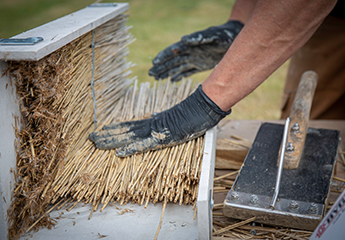Reed thatch as a building material absorbs CO2 instead of emitting it, making it a potential part of the solution for reducing the building industry's carbon emissions. However, this method requires documentation of the facade's fire safety properties. By impregnating the thatch with various natural materials such as lime and clay, DBI and CINARK at the Royal Academy, School of Architecture, are investigating the properties these natural materials add to the thatched construction in a MUDP project.
Using a series of mini-SBI tests, it has been possible to compare different impregnation materials. The best impregnation materials identified from the mini-SBI tests will subsequently be tested in a downscaled facade test.
Previously, the use of both reed thatch and mineral-based natural materials for fireproofing has been based on empirical knowledge. The project aims to bring us closer to being able to document the effect and its cause. Thus, the project will establish a foundation of knowledge for those who wish to create a thatched facade in the future. Additionally, the project has the potential to generate the documentation necessary for the use of thatched facades in construction. The MUDP project could be the first step toward incorporating thatched facades into BR18 in the long run, depending on the results of the upcoming fire tests.

